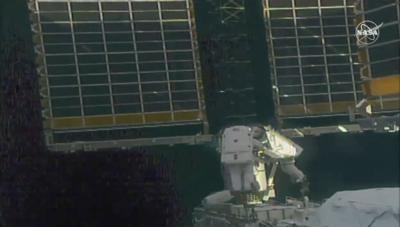Wed, Jun 23, 2021
Spacewalkers Have Now Spent A Total Of 63 Days And 56 Minutes Working Outside The Station
NASA astronaut Shane Kimbrough and ESA (European Space Agency) astronaut Thomas Pesquet concluded their spacewalk at 2:10 p.m. EDT, after 6 hours and 28 minutes. In the eighth spacewalk of the year outside the International Space Station, the two astronauts completed the deployment of a new ISS Roll-Out Solar Array (iROSA) on the far end of the left (port) side of the station’s backbone truss structure (P6).

Kimbrough and Pesquet successfully unfolded the solar array, bolted it into place, and connected cables to the station’s power supply to complete deployment. Additionally, the astronauts removed and stowed hardware in preparation for releasing the second iROSA from the flight support structure for installation. The pair will work toward the second solar array upgrade – this one on the P6 truss’ 4B power channel – during another spacewalk, tentatively scheduled for June 25.
NASA is augmenting six of the eight existing power channels of the space station with new solar arrays to ensure a sufficient power supply is maintained for NASA’s exploration technology demonstrations for Artemis and beyond as well as utilization and commercialization.
This was the eighth spacewalk for Kimbrough, the fourth for Pesquet, and the fourth they have conducted together. Kimbrough has now spent a total of 52 hours and 43 minutes spacewalking, and Pesquet’s total spacewalking time is 26 hours and 15 minutes.

Space station crew members have conducted 240 spacewalks in support of assembly and maintenance of the orbiting laboratory. Spacewalkers have now spent a total of 63 days and 56 minutes working outside the station.
In November 2020, the International Space Station surpassed its 20-year milestone of continuous human presence, providing opportunities for unique research and technological demonstrations that help prepare for long-duration missions to the Moon and Mars and also improve life on Earth. In that time, 244 people from 19 countries have visited the orbiting laboratory that has hosted nearly 3,000 research investigations from researchers in 108 countries and areas.
More News
From 2023 (YouTube Edition): "Ain’t Your Daddy’s Super Cub”—Don Wade Co-owned by Don and Ron Wade—the former of Don’s Dream Machines, a storied >[...]
Pilot-Rated Passenger Reported That The Pilot Did Not Adequately “Round Out” The Landing Flare And The Airplane Bounced And Yawed To The Right Analysis: The pilot state>[...]
Dead Reckoning Dead reckoning, as applied to flying, is the navigation of an airplane solely by means of computations based on airspeed, course, heading, wind direction, and speed,>[...]
Aero Linx: Lake Amphibian Club This website is created and sponsored by the Lake Amphibian Club, to help spread the word about these wonderful, versatile amphibians that can land j>[...]
“I am deeply honored to be sworn in as NASA administrator. NASA’s mission is as imperative and urgent as ever — to push the boundaries of human exploration, ignit>[...]
 Classic Aero-TV: In Praise of Alabamas Patriot Aircraft USA
Classic Aero-TV: In Praise of Alabamas Patriot Aircraft USA NTSB Final Report: Cirrus Design Corp SR22
NTSB Final Report: Cirrus Design Corp SR22 ANN's Daily Aero-Term (12.21.25): Dead Reckoning
ANN's Daily Aero-Term (12.21.25): Dead Reckoning ANN's Daily Aero-Linx (12.21.25)
ANN's Daily Aero-Linx (12.21.25) Aero-News: Quote of the Day (12.21.25)
Aero-News: Quote of the Day (12.21.25)




